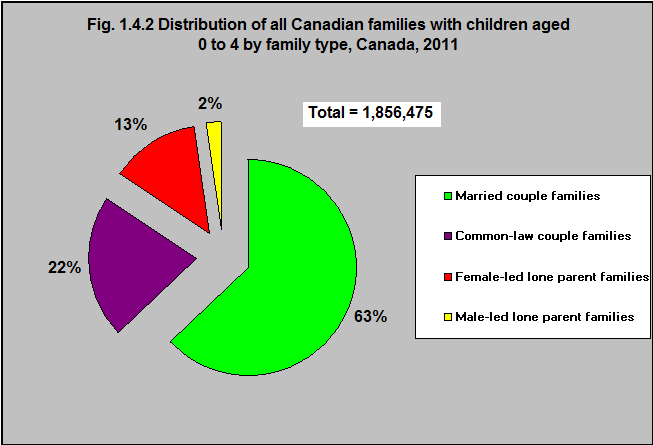Distribution of Canadian families with children aged 0 to 4, by family type, Canada, 2011

Source: CICH graphic created using data adapted from Statistics Canada, 2011 National Household Survey, Statistics Canada Catalogue no. 98-312-X2011024. http://census.gc.ca/census-recensement/2011/dp-pd/tbt-tt/Rp-eng.cfm?LANG=E&APATH=5&DETAIL=0&DIM=0&FL=A&FREE=0&GC=2478015&GID=0&GK=3&GRP=0&PID=102075&PRID=0&PTYPE=101955&S=0&SHOWALL=0&SUB=0&Temporal=2011&THEME=89&VID=0&VNAMEE=&VNAMEF= -accessed March 19, 2017.
According to the 2011 National Household Survey, over 60% of Canadian families with children under age 5 were married couple families. A further 22% were common-law couple families. 15% were lone parent families – the majority being female-led.
These proportions varied between the provinces and territories. In Quebec, almost half (48%) of all families with young children were couple families living common-law. That percentage was about 12% in Ontario.1
The proportion of families with young children who were lone parents ranged from 12.5% in Quebec to about 24% in Newfoundland & Labrador and Nova Scotia and 25% in Nunavut.1
1Statistics Canada, 2011 National Household Survey, Statistics Canada Catalogue no. 98-312-X2011024, accessed March 19, 2017.
Implications
While the majority of Canadian children under age 5 live with both parents – 15% of them – more than 275,000 – live in lone-parent families. Lone-parents face the same challenges as other parents, but often have fewer human and financial resources to meet those challenges. For example, they may have increased problems harmonizing work and childcare schedules. They may be more likely to experience isolation and less likely to find time for themselves. Policies and programs that provide affordable, accessible child care; workplace policies that support parenting; and policies that support secure employment with adequate income can all change these realities for lone-parent families.
